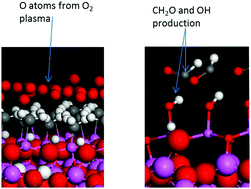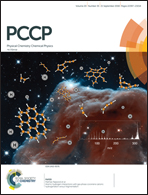First principles mechanistic study of self-limiting oxidative adsorption of remote oxygen plasma during the atomic layer deposition of alumina†
Abstract
Plasma-enhanced atomic layer deposition (ALD) of metal oxides is rapidly gaining interest, especially in the electronics industry, because of its numerous advantages over the thermal process. However, the underlying reaction mechanism is not sufficiently understood, particularly regarding saturation of the reaction and densification of the film. In this work, we employ first principles density functional theory (DFT) to determine the predominant reaction pathways, surface intermediates and by-products formed when constituents of O2-plasma or O3 adsorb onto a methylated surface typical of TMA-based alumina ALD. The main outcomes are that a wide variety of barrierless and highly exothermic reactions can take place. This leads to the spontaneous production of various by-products with low desorption energies and also of surface intermediates from the incomplete combustion of –CH3 ligands. Surface hydroxyl groups are the most frequently observed intermediates and are formed as a consequence of the conservation of atoms and charge when methyl ligands are initially oxidized (rather than from subsequent re-adsorption of molecular water). Anionic intermediates such as formates are also commonly observed at the surface in the simulations. Formaldehyde, CH2O, is the most frequently observed gaseous by-product. Desorption of this by-product leads to saturation of the redox reaction at the level of two singlet oxygen atoms per CH3 group, where the oxidation state of C is zero, rather than further reaction with oxygen to higher oxidation states. We conclude that the self-limiting chemistry that defines ALD comes about in this case through the desorption by-products with partially-oxidised carbon. The simulations also show that densification occurs when ligands are removed or oxidised to intermediates, indicating that there may be an inverse relationship between Al/O coordination numbers in the final film and the concentration of chemically-bound ligands or intermediate fragments covering the surface during each ALD pulse. Therefore reactions that generate a bare surface Al will produce denser films in metal oxide ALD.



 Please wait while we load your content...
Please wait while we load your content...